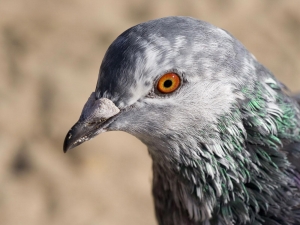Mother's milk best for growing babies ...
Research news
Deakin University scientists have revealed some of the secrets behind the pigeon’s rare ability to produce ‘milk’ to feed its young.
Deakin PhD student Meagan Gillespie and research fellow Dr Tamsyn Crowley, along with colleagues from the University’s Institute for Technology Research and Innovation and CSIRO Livestock Industries, have studied the genes behind pigeon ‘milk’ production. They found that, like mammalian milk, it contains antioxidants and immune-enhancing proteins important for the growth and development of the young.
“Producing milk to feed babies is normally the domain of mammals, including humans. However, the pigeon is one of only three bird species (the others being flamingos and male emperor penguins) to produce a milk-like substance to feed their young,” Dr Crowley explained.
“We looked at the genes involved in the production of pigeon ‘milk’ and found that it contains antioxidants and immune-enhancing factors. This suggests that, like mammalian milk, it plays a key role in enhancing the immune system of the developing baby.”
Both female and male pigeons produce a nutrient rich substance in their crop to feed their young (squabs). This substance has been likened to lactation in mammals and is referred to as pigeon ‘milk’. This ‘milk’ is essential for the growth and development of the pigeon squab, and without it they fail to thrive.
“Bird crops are normally used to store food. However, in the pigeon the crop changes prior to ‘lactation’ in response to hormones and returns to its ‘non-lactating’ state at the end of the lactation period, a bit like the mammary gland,” Ms Gillespie explained.
“During ‘lactation’, a curd-like substance is created from fat-filled cells that line the crop and regurgitated to feed the squab. This ‘milk’ contains protein, fats, minerals and antibodies to provide nutrition to the young.”
While studies have investigated the nutritional value of pigeon ‘milk’, very little is known about what it is or how it is produced.
“This study has provided an insight into the process of pigeon ‘milk’ production by studying the genes expressed in the ‘lactating’ crop,” Ms Gillespie said.
“Birds are different to other animals in that they don’t have sweat glands, but they do have the ability to accumulate fat in their outer skin cells (keratinocytes) which act like sweat glands. We found that the evolution of pigeon ‘milk’ appears to have developed from the ability of these outer skin cells to accumulate fat.
“The way pigeon ‘milk’ is produced is an interesting example of the evolution of a system with similarities to mammalian lactation, with pigeon ‘milk’ fulfilling a similar function to mammalian milk but produced in a different way.”
The results of the study will be published this week in BioMed Central’s journal BMC Genomics.
About pigeon ‘milk’
The crop in most species of birds is normally used as a food storage area. It is located between the oesophagus and the top of a bird’s stomach where food is moistened before further breakdown and digestion through the gastrointestinal tract.
The pigeon is one of only three bird species (the others being flamingos and male emperor penguins) known to produce ‘milk’ to feed their young.
In pigeons the milk starts to be produced in the crop of the parent birds two days before eggs hatch.
During ‘lactation’, a curd-like substance is created from fat-filled cells that line the crop and regurgitated to feed the squab. This ‘milk’ is made up of protein (around 60 per cent), fat (up to 36 per cent), a small amount of carbohydrate (up to three per cent), a range of minerals and antibodies.
Squabs are fed the ‘milk’ until they are around 10 days old. Once the young are weaned the ‘milk’ stops being produced.
The unique qualities of pigeon milk have been shown in previous studies.
One study tried replicating pigeon ‘milk’ however, for the squabs fed the artificial substance, their growth was either very poor or they died. This suggests that there is a unique quality to the pigeon milk that is necessary for squab growth and development.
In another study, when pigeon ‘milk’ was fed to chickens their growth rate improved by 38 per cent. Since this study, it has been shown that pigeon ‘milk’ contains certain antibodies, which provides further evidence that it is not just a nutrient-based substance.
Share this story
 Pigeons have a rare ability to produce 'milk' to feed their young.
Pigeons have a rare ability to produce 'milk' to feed their young.
